



Princeton Battlefield State Park
500 Mercer St.
Map / Directions to the Princeton Battlefield State Park
Map / Directions to all listed Princeton Revolutionary War Sites
For current hours and admission information, see the Princeton Battlefield State Park Website
Most of 1776 had been a difficult one for the American army under George Washington. Then in December, after months of defeat and retreat, Washington came up with the bold plan to cross the Delaware for a surprise attack on the Hessians at Trenton. The American victory that resulted is what is now known as the First Battle of Trenton. Several days later, this was followed up with another victory at the Second Battle of Trenton. In the evening following the second Battle, Washington held an important council of war. The decision was made there to attack the portion of the British army that was then occupying Princeton, about twelve miles away. During the evening of January 2-3, 1777, Washington's troops marched from Trenton to Princeton.
The early part of the fighting occurred at this site. American troops approached in two columns on the morning of January 8. The right column passed around a wooded area by the nearby Friends Meeting House, which still exists today (See entry below on this page). Around 8 a.m., American troops clashed with British soldiers under Colonel Mawhood here in the orchard of Thomas Clarke. Clarke's house, which had been built in 1772, still stands here and is used by the park as a museum. It has furnishings from the Revolutionary War era, and exhibits which include a large collection of firearms from the period.
Later fighting occurred that day in the area at and around Nassau Hall of Princeton University, which was then known as the College of New Jersey. (See Nassau Hall entry lower on this page.) British troops occupying Nassau Hall surrendered, and Washington's army won its third victory in ten days. Following the Battle of Princeton, Washington and his army headed to Morristown for winter quarters. The war would last another 6 years, and the American Army and Washington had a great deal of hardship to encounter over those years. But the events of the ten days from December 25, 1776 to January 3, 1777 had shown that Washington's army could survive against the British army. Their victories greatly improved the morale of both the army and the country. [1]
Princeton Battlefield has a number of plaques and markers to explain the events, which helps visitors understand the battle as they walk over the park grounds. Three of the notable spots in the park are detailed below:

The highest ranking casualty at the Battle of Princeton was General Hugh Mercer, for whom Mercer County was later named. Mercer died from wounds suffered at the battle, when he was clubbed and bayoneted by British soldiers after having his horse shot out from under him. He was carried to the Thomas Clarke House, where he survived for nine days before dying.
A legend later grew that after Mercer was wounded, he lay under an oak tree, refusing to leave the battlefield until victory had been achieved. While the story is not true, the legend stuck, and that tree became known as the "Mercer Oak." Even though the story about Mercer is not true, it is believed that the original oak tree was here in 1777, and therefore was at least a witness to the Battle of Princeton, close to where Mercer was actually wounded.
The "Mercer Oak" survived for over two centuries. Its image became commonly associated with the region, appearing on the official seals of both Princeton Township and Mercer County. The "Mercer Oak" finally collapsed on March 3, 2000. An offspring of the original tree, grown in 1981 from an acorn from the "Mercer Oak," was planted here in 2001. [2]
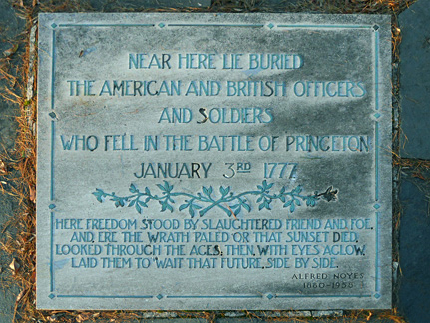
Memorial
On the west side of the park, across Mercer Street from the Thomas Clark house, there is a memorial to thirty-six unknown soldiers who died at the Battle of Princeton. These include fifteen American and twenty-one British soldiers. [3]
A marker to these soldiers quotes four lines from the poem Princeton by Alfred Noyes:
"Here Freedom stood by slaughtered friend and foe,
And, ere the wrath paled or that sunset died,
Looked through the ages; then, with eyes aglow,
Laid them to wait that future, side by side."

Portico
Standing in front of the gravesite and memorial is a colonnade which has its own history. It was originally the portico of a home in Philadelphia owned by a man named Matthew Newkirk. The portico was designed in 1836 by architect Thomas Ustick Walter, who also designed the dome on the United States Capitol Building.
The portico was moved to Princeton in 1900 where it became the entrance to Mercer Manor, which stood on the east side of the Battlefield. When Mercer Manor was demolished in 1937, its owners, the Institute for Advanced Studies, gave the portico to the State of New Jersey. It was re-erected at this site in 1959, and was dedicated at a ceremony on November 11, 1959. [4]



Princeton Friends Meeting House and Cemetery
Richard Stockton Gravesite
470 Quaker Rd.
Map / Directions to the Princeton Friends Meeting House
Map / Directions to all Princeton Revolutionary War Sites
This Quaker meeting house stands about a hundred yards away from the Thomas Clarke house, as it did at the time of the Battle of Princeton. A column of American troops passed by a wooded area near the Meeting House just before the battle. After the battle, the meeting house was used as a hospital for both American and British troops. [5] This is still the active Princeton Friends Meeting House, holding meetings every Sunday.
Richard Stockton (1730-1781), who was one of five signers of the Declaration of Independence for New Jersey, is buried in the cemetery. His home, called Morven, is also located in Princeton and is shown in an entry lower on this page.
The four other Declaration of Independence signers representing New Jersey were:
• Abraham Clark, whose house was in Roselle; his gravesite is in Rahway
• John Hart, whose house and gravesite are in Hopewell
• Francis Hopkinson whose house is in Bordentown
• John Witherspoon, who lived at the Maclean House while president of Princeton University. He is buried at the Princeton Cemetery. There is also a fine statue of him on the campus of Princeton University. All three of these locations have listings below on this page.
In addition:
• George Clymer, who signed for Pennsylvania, is buried in the Quaker Meeting House cemetery in Trenton.
• Joseph Hewes, who signed for North Carolina, was born in Princeton. His house Maybury Hill is shown lower on this page.


Nassau Hall
Princeton University at Nassau St.
Map / Directions to Princeton University
Map / Directions to all Princeton Revolutionary War Sites
After the early fighting at the Battle of Princeton around the orchard of Thomas Clark (site of Princeton Battlefield State Park), fighting moved towards the center of town by the college. Nassau Hall was occupied by British soldiers who broke out the windows to defend the building with their muskets. The American artillery opened cannon fire on the building; a dent from a cannonball is still visible on the west wing. The British soldiers inside surrendered. [6]
After their victory at Princeton, Washington's troops headed to Morristown for Winter Quarters. Nassau Hall was then briefly re-occupied by British troops en route from Trenton and Maidenhead (now Lawrenceville) to New Brunswick. Several days later the building was occupied by American troops under General Putnam and. was used as a barracks, hospital, and military prison. Extensive damage was done to the building from occupations by British and American troops, which took years to repair. [7]
Congress met in Nassau Hall from June 30 - November 4, 1783. [8] During this time, the Treaty of Paris was signed on September 3, officially ending the Revolutionary War. Due to the slowness of Atlantic Ocean travel in the 1780's, it took almost two months for the news to reach America from France. It was here, on October 31, 1783, that Congress received the news that the Treaty of Paris had been signed, and the war was officially over. General Washington was also in New Jersey when he received news of the treaty the same day; he was headquartered at Rockingham in Kingston. I consider it only fitting that after New Jersey's significant role in the Revolutionary War, both Congress and General Washington were in New Jersey at the time they received this momentous news!

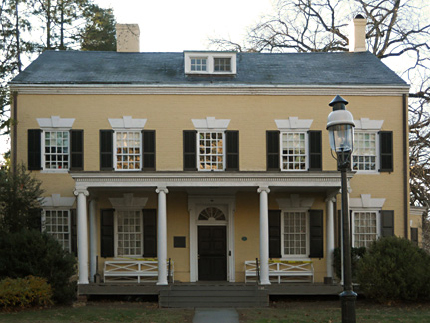
Maclean House (President's House)
Princeton University at Nassau St.
Map / Directions to Princeton University
Map / Directions to all Princeton Revolutionary War Sites
The Maclean House (also known as President's House) was erected in 1756, and it served as the official residence of Princeton's president until 1878. In late 1756, before construction on the house was completed, its first occupants moved in: then-president of Princeton Aaron Burr Sr., his wife Esther, their daughter Sally, and their son Aaron Jr., who was less than one year old. Sadly, within a year and a half, Aaron Sr. and Esther died, and the now orphaned children were taken to live elsewhere. [9] Aaron Burr Jr. later attended the college as a student; he graduated in the Class of 1772. Burr went on to serve as a Colonel in the Revolutionary War, and later as the country's third Vice President. In 1804, he mortally wounded Alexander Hamilton in their famous duel in Weehawken, NJ.
Several other future Revolutionary War figures attended the college at the same time as Burr, including William Bradford and Philip Vickers Fithian, who also graduated in 1772, and James Madison and Philip Freneau who graduated the year before.
Declaration of Independence signer John Witherspoon (1723 - 1794) lived in this house from 1768 to 1794 while he was the president of Princeton University (then known as the College of New Jersey). [10] In 1774, John Adams stopped at Princeton on August 27-28, while en route to the First Continental Congress in Philadelphia. According to Adams' diary, he drank a glass of wine in this house with Witherspoon on the 27th. [11]
Some of the plant life around Maclean House is of interesting Revolutionary War era significance. In front of the house are two trees known as the "Stamp Act Sycamores" because of a legend that they were planted in honor of the repeal of the Stamp Act in 1766. [12] While there is some question about their connection to the Stamp Act, the fact that they were planted in 1766 means that they were already standing here in 1777 when the Battle of Princeton took place, and cannonballs hit the nearby Nassau Hall.
Behind the Maclean House is a garden which includes flowers and shrubs grown from plants at George Washington's Virginia home, Mount Vernon. These include a row of English Boxwood hedges that were grown from hedges planted at Mount Vernon in November 1798. Known as the Washington Memorial Garden, the garden was originally a gift of the Princeton Class of 1936. Additions have been made over the years, including a Sweet Buckeye planted here on Arbor Day 1999, which is a direct descendent of one planted in the1780's at Mount Vernon by Washington. [13]



John Witherspoon Statue
Princeton University at Nassau St.
Map / Directions to Princeton University
Map / Directions to all Princeton Revolutionary War Sites
John Witherspoon was a signer of the Declaration of Independence, as well as the President of Princeton University. The statue by Scottish sculptor, Alexander Stoddart, was dedicated on November 10, 2001. [14] Three plaques on the base of the statue, detail the life of John Witherspoon, who was born in Scotland in 1723, and had immigrated to New Jersey in 1768. One of the plaques, titled "Patriot", relates his political role during the Revolutionary War era. The text of that plaque reads: [15]
" 'He is as high a Son of Liberty as any Man in America' - John Adams 1774
"Witherspoon embraced America from his arrival in Philadelphia and his warm reception in Princeton. As relations with Great Britain became strained, he tolerated the growing student unrest at the College and was patient with demonstrations favoring independence even before he became an advocate from the pulpit.
"With eight other men he formed the Somerset County Committee of Correspondence in 1774 and he was elected to the New Jersey Provincial Congress. In June 1776, he was chosen as one of New Jersey's delegates to the Continental Congress in Philadelphia. He became one of the most forceful proponents of the Declaration of Independence, the only minister and the only college president among the fifty-six signers. He signed the Articles of Confederation and was selected in 1787 to attend the New Jersey ratifying convention for the Constitution."
John Witherspoon died November 15, 1794. He is buried at Princeton Cemetery. (See the Princeton Cemetery entry lower on this page)

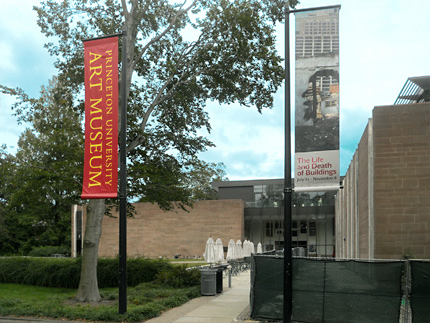
Princeton University Art Museum
Princeton University at Nassau St.
Map / Directions to Princeton University
Map / Directions to all Princeton Revolutionary War Sites
For current hours and admission information, see the: www.artmuseum.princeton.edu
Charles Wilson Peale's 1784 painting, George Washington at the Battle of Princeton, hangs in the American Art room of the Princeton Art Museum.
Peale (1741-1827) served in the Revolutionary War and fought at the Battle of Princeton
The Princeton University website contains the following description of the painting: [16]" 'George Washington at the Battle of Princeton, January 3, 1777' was painted by Charles Willson Peale, one of the most famous early American artists, in 1784. This portrait is distinct because it is one of only a few Washington sat for during his lifetime. The College paid Peale's fee with a 50-guinea gift that Washington had presented as a mark of his esteem and to pay for war damages to Nassau Hall.
"In the background of the portrait, beneath Washington's upraised sword arm, stands Nassau Hall as it appeared from the south in 1777. The scene suggested is the closing phase of the battle: the British retreat toward the building, following a red flag; the American army advances, led by a blue banner. At Washington's feet lies General Hugh Mercer, the namesake of New Jersey's Mercer County, who was mortally wounded during the fighting. Behind Washington is a surgeon and another officer bearing an American flag."

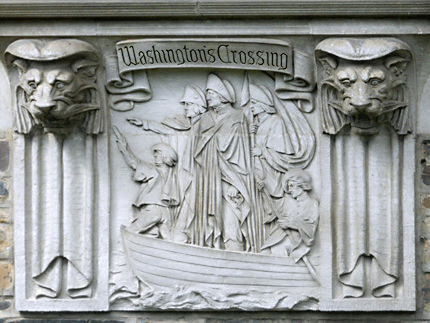

Henry Hall
Princeton University
University Pl. near Dickinson
St.
Map / Directions to Henry Hall
Map / Directions to all Princeton Revolutionary War Sites
These two bas reliefs are located on the Henry Hall building on the Princeton University campus. One depicts Washington's Crossing of the Delaware, and the other depicts the mortal wounding of General Mercer at the Battle of Princeton. These are both located on the inner side of the building. To view them, walk through the opening on University Place by Dickinson Street, and then turn to your right.


Nassau Presbyterian Church
61 Nassau St.
Map / Directions to Nassau Presbyterian Church
Map / Directions to all Princeton Revolutionary War Sites
The First Presbyterian Church of Princeton was built at this site in 1766. Declaration of Independence signer, John Witherspoon, served as the pastor of the church for 25 years, while also serving as the President of Princeton University.
That original church building was occupied by British troops before the Battle of Princeton, and afterwards by American troops. It was heavily damaged by these occupations, with pews and galleries stripped for firewood.
The original building was destroyed in a fire when during Fourth of July celebrations in 1835, a skyrocket landed on the roof. The current church building was then built, and it was dedicated in 1836. [17]



Princeton Battle Monument
Stockton St. (Rt. 206) at Monument Drive
Map / Directions to the Princeton Battle Monument
Map / Directions to all Princeton Revolutionary War Sites
This monument depicts General Washington leading his troops into the Battle of Princeton. In front of him is an allegorical depiction of Liberty. The bottom left shows General Mercer fallen to the ground as he was mortally wounded at the battle. Beaux Arts sculptor Frederick MacMonnies designed the monument, assisted by architect Thomas Hastings. [18]
The Princeton Battle Monument was dedicated on June 9, 1922. Then-President Warren G. Harding attended the ceremony, and gave a speech which included the following: [19]
"My Fellow Americans: We have come here to say the formal words of dedication and consecration before a monument in marble and granite. But we stand to say these words in the presence of another monument, which is the true memorial of the events we celebrate. The real monument to the achievement of Washington's patriotic army in the Trenton-Princeton campaign is not in these beautified workings of bronze or carvings of stone. It rears itself in the institutions of liberty and representative government, now big in the vision of all mankind...
"So you have erected here at Princeton a fitting memorial to the heroes and heroism of that day. We bring and lay at its foot the laurel wreaths which gratitude and patriotic sentiment will always dedicate to those who have borne the heat and burden of the conflict. Let us believe that their example in all of the future may be, and thus far it has been, a glorious inspiration to the country."

There are four small monuments located on the walkway leading to the Princeton Battle Monument, near the parking lot:
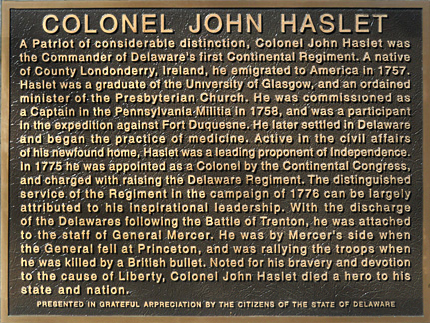

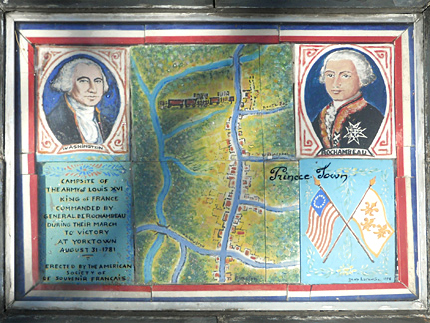


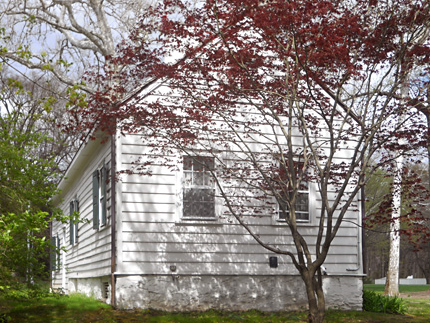
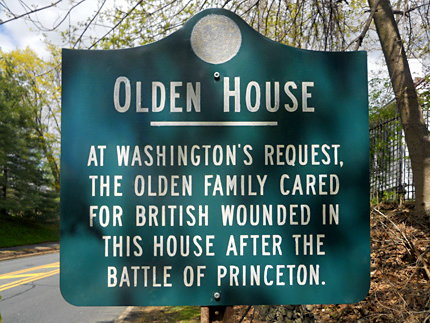
Olden House
344 Stockton Rd.
Map / Directions to the Olden House
Map / Directions to all Princeton Revolutionary War Sites
Located within the ground of Drumthwacket, which is open for guided tours on Wednesdays.
Reservations are necessary, and can be made on their website:
http://www.drumthwacket.org
After the Battle of Princeton, Washington stopped at this house and asked that two wounded British soldiers be cared for. The following account was written by Robert Lawrence, who was 84 years old at the time, and living at the house with his daughter Elizabeth and his son-in-law, David Olden. [20]
(Note that the spelling and punctuation have not been corrected. The misspellings and missing punctuation are part of the original publication.)
"Almost as soon as the firing was over our house was filled and surrounded with Gen' Washington's Men, and himself on horseback at the door. They brought in with them on their Shoulders two Wounded Regulars [British soldiers], one of them was shot in at his hip and the bullet lodged in his groin, and the other was shot through his body Just below his short ribs he was in very great pain and bled much out of both sides, and often desired to be removed from one place to another, which was done Accordingly and he dyed about three o'clock in the afternoon They was both Used very tenderly by the Rebels (as they call them) The other also bled much and they put a Cloth dipt in vinegar to the wound to Stop it and three of them Stay'd with the wounded men near an hour after the Others were gone, the man that lived was left at our house above two days and one night With his Wound not drest, before the Regulars that was left to take care of the sick and wounded would take him away, though they had notice that day after the battle."
The house is often referred to as the Thomas Olden house. Thomas was David's brother. The property surrounding the house was owned by members of the Olden Family from the late 1600's to the late 1800's. The Drumthwacket house on the property was built in 1835 by Charles Smith Olden. The house was later greatly expanded by its later owner, financier Moses Taylor Pyne. Drumthwacket has been used as the official residence of the Governor of New Jersey since 1981. [21]


Washington's Spring
Stockton St. and Edgerstoune Rd.
Map / Directions to Washington's Spring
Map / Directions to all Princeton Revolutionary War Sites
This is a small monument that stands in the yard in front of a house at the corner of Stockton St. and Edgerstoune Rd.
It states that on January 3, 1777, after the Battle of Princeton, Washington and his troops stopped to drink water from a nearby spring. [22]


Washington Route Marker
Nassau St. and Washington Rd.
Map / Directions to Washington Route Marker
Map / Directions to all Princeton Revolutionary War Sites
Following their victory at the Battle of Princeton, Washington and his army went to Morristown for winter quarters. This marker is the first of a series of thirteen showing the route taken by Washington's army from Princeton to Morristown, January 3 -7, 1777.
Other markers in this series can be found in Kingston, Griggstown, Bridgewater, Somerville, Bedminster, Bernardsville, Basking Ridge, Harding Township and Morris Township.
For a map tracing the route of all thirteen markers from Princeton to Morristown, click here.


Morven Museum & Garden
55 Stockton St. (Rt. 206)
Map / Directions to Morven
Map / Directions to all Princeton Revolutionary War Sites
For current hours and admission information, see the
Morven Museum & Garden Website
Morven was built in the 1750's by Richard Stockton (1730 – 1781), a signer of the Declaration of Independence for New Jersey. After a 1758 fire, the house was rebuilt and named Morven, which means “big mountain” in Gaelic. Members of the Stockton family lived in this house until the early 20th century. From 1945-1981, it served as the New Jersey Governor's Mansion. [23]
Stockton is buried at the Princeton Friend's Meeting House Cemetery. (See entry above on this page.)


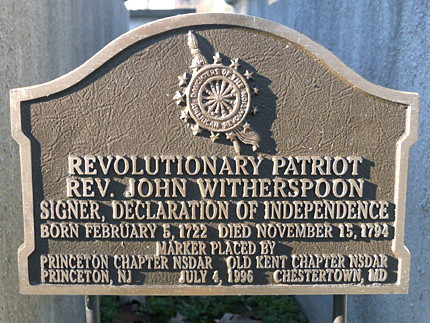
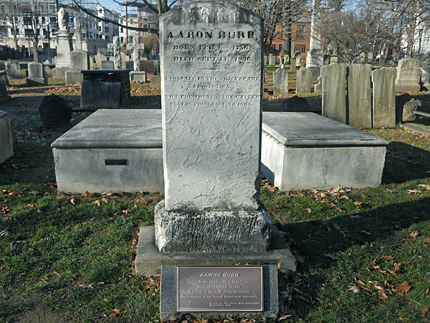

Princeton Cemetery
Greenview Ave.
Map / Directions to Princeton Cemetery
Map / Directions to all Princeton Revolutionary War Sites
Princeton Cemetery Website
The Princeton Cemetery contains the graves of several notable Revolutionary War figures: [24]
• John Witherspoon (February 5, 1722 -November 15, 1794) - Declaration of Independence signer, President of Princeton University 1768–94
• Aaron Burr (February 6, 1756 - September 14, 1836) - Colonel in the Revolutionary War, Third Vice President of the United States, fatally wounded Alexander Hamilton in their duel in Weehawken, NJ. Burr's father, Aaron Burr, Sr., is buried several feet from him. Burr Sr. was the President of Princeton University 1748–57.
• John Berrien (Died April 22, 1772, aged 60) - Died before the Revolutionary War began, but his house, Rockingham, served as Washington's headquarters for several months in 1783, when it was rented by John's widow, Margaret Berrien. It was at Rockingham on October 31, 1783, that Washington received the news that the Treaty of Paris had been signed and the war was officially over.
There are other notable burials here that are not connected to the Revolutionary War. Grover Cleveland, the only U.S. President to have been born in New Jersey, is buried here. (Born in Caldwell March 18, 1837, died in Princeton June 24, 1908.) President Cleveland's birthplace in Caldwell is a New Jersey State Historic Site and is open for tours. See their website for more information: www.clevelandbirthplace.org


Bainbridge House
158 Nassau St.
Map / Directions to Bainbridge House
Map / Directions to all Princeton Revolutionary War Sites
Bainbridge House is one of the oldest surviving buildings in Princeton. It was built in 1766 by Job Stockton, a cousin of Declaration of Independence signer Richard Stockton. Job Stockton was a successful tanner who owned a tannery complex in Princeton.
Job Stockton died in 1771. His brother Robert Stockton leased this house in 1774 to a doctor named Absalom Bainbridge, Dr. Bainbridge remained loyal to the British in the Revolutionary War, and he served as a surgeon in a Loyalist brigade called the New Jersey Volunteers. After the British defeat at the Battle of Princeton, he fled Princeton. Absalom's son, William Bainbridge, who was born in the house on May 7, 1774, went on to become a Commodore in the U.S. Navy, and commanded the U.S.S. Constitution ("Old Ironsides"). He emerged as a hero of the War of 1812.
The Bainbridge House provided accommodations for the Continental Congress when it met in Princeton's Nassau Hall from June to November 1783. [25]

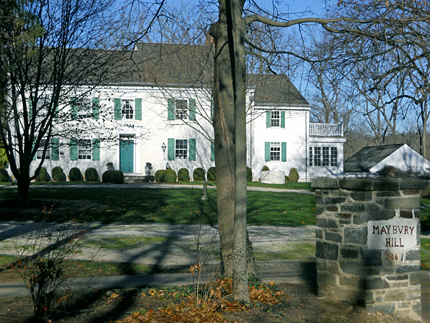

Maybury Hill
346 Snowden Ln.
Map / Directions to Maybury Hill
Map / Directions to all Princeton Revolutionary War Sites
This house is a private residence.
Please respect the privacy and property of the owners.
Maybury Hill was built circa 1725 and rebuilt in 1735 after a fire. Joseph Hewes was born here in 1730 and spent his early years. He later signed the Declaration of Independence for North Carolina. [26]


Washington-Rochambeau Route Marker
Stockton St.
In front of Trinity Church
Map / Directions to Washington Rochambeau Route Marker
Map / Directions to all Princeton Revolutionary War Sites
This is one of a series of markers in New Jersey showing the route taken by American and French troops to the October 19, 1781 Battle of Yorktown, which would prove to be the final and decisive major battle of the Revolutionary War. This particular marker states that the encampment at this site was from August 29 - September 1, 1781, but it was more likely August 31 - September 1. [27]
Additional markers related to the path to the Battle of Yorktown can be found in Mahwah, Pequannock, Montville, Whippany, Liberty Corner, and Montgomery.

1. ^ For details about the Battle of Trenton, the events leading up to it, and its aftereffects, see:
David Hackett Fischer, Washington's Crossing (New York: Oxford University Press, 2004)2. ^ "The Mercer Oak" historic plaque at Princeton Battlefield State Park: State of New Jersey, Division of Parks and Forestry
• David Hackett Fischer, Washington's Crossing (New York: Oxford University Press, 2004) pages 332-333• Click here to read the article "The Mercer Oak falls - Rooted in history, and leaving a legacy" by Rich Tucker, published in The Daily Princetonian on March 9, 2000, six days after the tree collapsed.
3. ^ and 4. ^ Information about the memorial, graves, portico, and dedication was drawn from:
• "Colonnade and Gravesite" plaque in Princeton Battlefield State Park / State of New Jersey; Division of Parks and Forestry
• "The Preservation and Rebuilding here of this Historic Portico..." and "This is Hallowed Ground..." plaques on the portico
• "Portico to be Dedicated," Town Topics (Princeton), November 8-14, 1959, p. 4 and 14 / Available at the Internet Archive here• The full text of the poem, Princeton, can be read at the Internet Archive here
5. ^ • William S. Stryker, The Battles of Trenton and Princeton (Boston and New York: Houghton Mifflin and Company,1898) pages xv, 276, and 278 / Available to be read at the Internet Archive here
• David Hackett Fischer, Washington's Crossing (New York: Oxford University Press, 2004) pages 320 (map) and 3256. ^ • David Hackett Fischer, Washington's Crossing (New York: Oxford University Press, 2004) pages 338-339
• William S. Stryker, The Battles of Trenton and Princeton (Boston and New York: Houghton Mifflin and Company,1898) pages 289-290 Available to be read at the Internet Archive here7. ^ • Varnum Lansing Collins, Princeton (New York: Oxford University Press, 1914) p. 79 Available to be read at the Internet Archive here
• William S. Stryker, The Battles of Trenton and Princeton (Boston and New York: Houghton Mifflin and Company,1898) pages 448, and 456-457. Available to be read at the Internet Archive here8. ^ The first three sessions (June 30, July 1, and July 2) may have taken place at "Prospect," the home of Colonel George Morgan in Princeton, with the remaining sessions (July 3 - November 4) having taken place at Nassau Hall.
For more about this, see:
Varnum Lansing Collins, The Continental Congress at Princeton (Princeton: The University Library, 1908) pages 55-58 Available to be read at the Internet Archive here
9. ^ • William K. Selden, Maclean House of Princeton University - A National Historic Landmark (Princeton: The Trustees of Princeton University, Produced by the Office of Communications, Princeton University, 2006) p. 9 Available as a PDF on the Princeton University website
• Nancy Isenberg, Fallen Founder - The Life of Aaron Burr (New York: Viking, 2007) p. 4 - 610. ^ William K. Selden, Maclean House of Princeton University - A National Historic Landmark (Princeton: The Trustees of Princeton University, Produced by the Office of Communications, Princeton University, 2006) p. 10 - 11 Available as a PDF on the Princeton University website
11. ^ "We went into the Presidents House, and drank a Glass of Wine." From John Adams Diary Entry, August 27, 1774. Available to be read at Adams Family Papers: An Electronic Archive, on the Massachusetts Historical Society website here
12. ^ James Consolloy, J. I. Merritt III, The Trees of Princeton University - An Arboreal Tour of the Campus (Princeton: The Trustees of Princeton University, 2011) Page 4. Available as a PDF on the Princeton University website
13. ^ • "Arbor Day Tree Planting Ceremony Planned" News release from the Princeton University Office of Communications, April 2, 1999
Available to be at the News Archive of the Princeton University's website.
• Raymond Rhinehart Princeton University: The Campus Guide (New York: Princeton Architectural Press, 2000) p. 8
• Stone marker by the hedges that reads, "These English boxwood plants were grown from George Washington's Hedges planted November 1798 on his Mount Vernon estate."14. ^ A plaque on the back of the base details the information about the statue: "This statue was dedicated on November 10, 2001. It was made in Paisley, Scotland, by Alexander Stoddart and is a duplicate casting of a statue dedicated in Paisley on June 22, 2001. The work was cast at the Morris Singer Foundry in Basingstoke, England. The architect for the plinth was T. Jeffery Clarke AIA of Princeton, New Jersey."
15. ^ Text of the "Patriot" plaque on the base of the statue.
The plaque does not identify the source of the John Adams quote, but it is from John Adams' diary entry of August 27, 1774. Adams was in Princeton en route to the First Continental Congress, which would meet in Philadelphia September 5 to October 26, 1774
Adams' diary entry can be viewed at the Adams Family Papers - An Electronic Archive, on the Massachusetts Historical Society website here16. ^ Princeton University website
17. ^ A Brief Account of the Heritage and Creation of Nassau Presbyterian Church - History page of the Nassau Presbyterian Church website
18. ^ Allan Marquand et. al., The Princeton Battle Monument (Princeton: Princeton University Press, 1922) pages 7-21
Available to be read at the Internet Archive here19. ^ "President Dedicates Princeton Monument" The Daily Princetonian, Volume 43, Number 84, June 12, 1922, available online in Princeton University's 'Papers of Princeton' Archive here
• The entire speech is quoted in:
Allan Marquand et. al., The Princeton Battle Monument (Princeton: Princeton University Press, 1922) pages 35-39
Available to be read at the Internet Archive here
Note that the two sources differ slightly in the wording. Where the The Daily Princetonian quotes "...before a monument in marble and granite", The Princeton Battle Monument quotes "...before a monument in stone".
The wording from The Daily Princetonian article, written within days of the event, has been used in the main entry.20. ^ [Robert Lawrence]; Edited by Varnum Lansing Collins, A Brief Narrative of the Ravages of the British and Hessians at Princeton in 1776-1777; a Contemporary Account of the Battles of Trenton and Princeton (Princeton: The University Library, 1906) p. 36-37
Available to be read at the Internet Archive here• This document was originally mistakenly believed to be the diary of Thomas Olden. In his book, Battles of Trenton and Princeton, William S. Stryker, who at the time possessed the document, identified it as such:
William S. Stryker The Battles of Trenton and Princeton (Boston and New York: Houghton Mifflin and Company,1898) p.129-130 Available to be read at the Internet Archive hereBy the time the manuscript was published as A Brief Narrative... in 1906, it was no longer believed to be the diary of Thomas Olden. In his introduction, editor Varnum Lansing Collins explains why the internal evidence of the manuscript shows that the manuscript could not have been written by Thomas Olden. However, although he concludes that the writer could not have been Thomas Olden, he does not attempt to identify the actual author.
A Brief narrative... p. vii - viii / Available to be read at the Internet Archive hereIn 1967, historian Samuel Stelle Smith identified the author as Robert Lawrence, based on the internal evidence of the manuscript.
Samuel Stelle Smith, The Battle of Princeton (Monmouth Beach, NJ; Philip Freneau Press, 1967) Appendix D, pg 3821. ^ History page of the Drumthwacket website
22. ^ Historic sign on the Washington's Spring Monument, placed by the NJ Society Sons of the Revolution in August 2002
23. ^ Morven Museum & Garden website
24. ^ Gravestones and markers in Princeton Cemetery
25. ^ • Locations and Historic People pages of the Historical Society of Princeton website
• New Jersey Volunteers List of Officers, 1776-1783, The On-Line Institute for Advanced Loyalist Studies
• William S. Stryker, The New Jersey Volunteers (Loyalists) In The Revolutionary War (Trenton: Printed for Private Distribution / Naar, Day & Naar, Book and Job Printers, 1787) p. 39-40
Available to be read at the Internet Archive here
26. ^ • State of New Jersey historic sign in front of Maybury Hill
• National Park Service: Signers of the Declaration - Survey of Historic Sites and Buildings - Maybury Hill
27. ^ This marker was placed by the Princeton Chapter of the Daughters of the American Revolution on October 19, 1981
• Robert A. Selig, Ph. D The Washington - Rochambeau Revolutionary Route in the State of New Jersey, 1781 - 1783 An Historical and Architectural Survey Volume I (Project Funding Provided by New Jersey Historic Trust Department of Community Affairs / State of New Jersey. Carl E. Nittinger - Project Director, 2006) p. xxix. Available as a PDF here
This study gives the dates for the encampment as August 31-September 1, which fits the timeline better than the August 29-September 1 date on the marker. The source listed is a French campsite map from The American Campaigns of Rochambeau's Army, 1780-1783: Volume II: Maps and Views by Howard C. Rice and Anne S.K. Brown, American. (Campsite map from the journal of unidentified officer of the Soissonnais Regiment in the Huntington Library, San Marino, CA.)